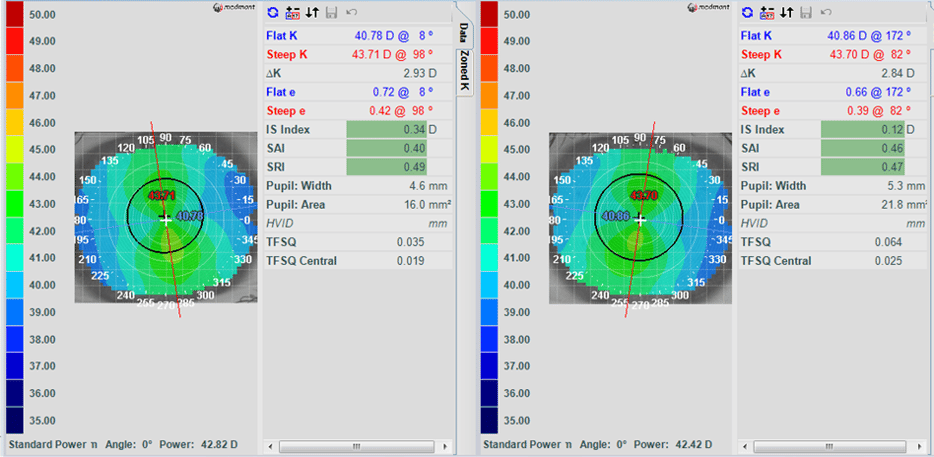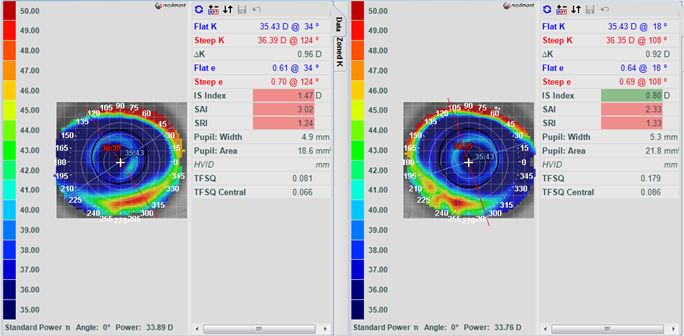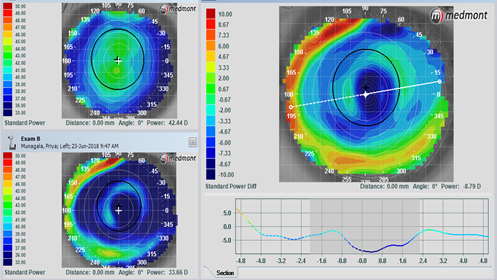by Kevin Chan, OD, MS, FAAO
Treehouse Eyes, Tysons Corner, VA
Case History
A 12-year-old female of Indian descent named P.M. has started wearing glasses since age 6; she said ‘her vision was OK, yet never perfect’. After having a comprehensive eye exam by the primary eye care provider, it was found that her myopia has worsened (again) by 1 diopter since the previous year. Later, she was referred to visit us for further evaluation of myopia management in our office. Her parents, who were also mildly nearsighted, were very concerned because they felt that their daughter’s eyesight has ‘worsened much faster than when they were at her age’.
K readings (Figure 1)
OD 40.76@016/ 43.61@106
OS 40.86@172/ 43.70@082
Subjective Rx
OD -10.50 -3.50 x010 20/20-1
OS -10.75 -3.00 x165 20/20-2
Cycloplegic Rx
OD -9.00 -1.50 x010 20/30-2
OS -9.00 -1.50 x162 20/40-1
(Note: The patient still favored a subjective Rx slightly more myopic than the cycloplegic result)
Pupil sizes
OD 4.6mm OS 5.3mm
Baseline AL (A-scan)
OD 27.90mm OS 28.58mm

Figure 1. Baseline corneal topographies (axial map) of the right eye (left) and of the left eye (right) performed by Medmont E300 topography. The black solid circle shown in the middle represents the pupil size in each eye.
Trial CLRx:
OD: 8.2 BC/14.8 Diam. -9.25 -2.75 x010 (+4.00 add) 2.5 D/C, 4.6 I/Z
OS: 8.2 BC/14.8 Diam. -9.50 -2.25 x165 (+4.00 add) 2.5 D/C, 4.6 I/Z
P.M. returned for the first follow-up visit since wearing the trial pair of SpecialEyes 54 Multifocal Toric Lenses three months ago. She reported generally good aided vision and comfort with the lenses during daytime. No over-refraction Rx was reported. She denied having fluctuating vision at distance and near, or any symptoms of halo present.
Aided VA (with multifocal toric lenses):
OD 20/25+2
OS 20/20-1

Figure 2. Initial lens fit was captured by corneal topographies. Both lenses are well-centered with distinct peripheral add region (shown in light blue enclosed in the pupil).
In January 2018, the patient returned for an 8-month follow-up visit. She reported steady and satisfactory subjective vision with current multifocal toric lenses all day long. She has been compliant with adhering to the quarterly replacement schedule and daily lubricant eye drops.
Aided VA (with multifocal toric lenses):
OD 20/20-1
OS 20/20-2
Aided length update (first data obtained by Pentacam AXL, Oculus):
OD 28.33mm
OS 28.44mm
(Note: Results are varied by instrumentation difference by A-scan: OD 27.90mm OS 28.58mm)
Six months later, the patient returned for the Year 1 annual assessment since the myopia treatment began. Her mother stated that her daughter has recently had a comprehensive examination by the primary eye care doctor two months ago. She was told that 'one of her eyes might have changed by 0.25 diopter.' Nevertheless, no known axial length measurement was reported. Longstanding white-without-pressure was evident in both eyes; yet no sign of retinal hole, tear, or detachment was noted upon dilated fundus assessment.
Current CLRx Parameters:
OD: 8.2 BC/14.8 Diam. -9.25 -2.75 x010 (+4.00 add) 2.5 D/C, 4.6 I/Z
OS: 8.2 BC/14.8 Diam. -9.50 -2.25 x165 (+4.00 add) 2.5 D/C, 4.6 I/Z
Aided VA (with multifocal toric lenses):
OD 20/25-3 (Over-refraction: Plano 20/25)
OS 20/25-2 (Over-refraction: -0.25 sph 20/25-2)
Non-cycloplegic ("dry") subjective Rx:
OD -10.50 -3.50 x010 VA 20/20
OS -10.5 -2.75 x165 VA 20/20
Axial length (Pentacam AXL):
OD 28.45mm (*28.38mm; <+0.10mm variation)
OS 28.44mm (*28.44mm; zero variation)
*Denotes results taken a year ago
Current axial length data showed unremarkable changes (it even remains numerically the same in OS!), which suggests no physiological (or axial) elongation resulting from myopia progression. Nevertheless, to improve the patient's overall subjective visual experience, I have discussed with the lab consultant to increase the distance-center (D/C) zone size by 0.2mm, resulting in a change from 2.5 D/C to 2.7 D/C for each lens. The goal is to enhance the visual acuity at distance without interference of the overall treatment goal.
 (A)
(A)
 (B)
(B)
Figure 3. Differential topographical maps (top right in diagram A and B) between pre-treatment (top left in diagram A and B) and post-revision upon the first year of treatment (bottom left in diagram A and B).
Six months later, P.M. returned to the office for a follow-up visit. She reported the quality of her aided vision has improved noticeably and it has continued to be stable throughout the entire day.
Aided VA (with the enlarged D/C zone size):
OD 20/20-3 (over-refraction: +0.25 -0.25 x030 20/20-3)
OS 20/20-1 (over-refraction: pl -0.25 x010 20/20)
Axial length data (18-month)
OD 28.47mm (*28.38mm)
OS 28.48mm (*28.44mm)
*Denotes results taken in January 2018
In July 2019, the patient returned to the office for the Year 2 annual assessment. She reported her aided vision with current custom soft multifocal toric lenses has been stable and consistent throughout the whole day. She denied any symptoms of dryness or other ocular concerns.
Aided VA:
OD 20/20-3 (over-refraction: +0.25 -0.25 x030 20/20-3)
OS 20/20-1 (over-refraction: pl -0.25 x010 20/20)
Non-cycloplegic ("dry") subjective Rx:
OD -9.75 -2.75 x015 20/20
OS -9.75 -2.75 x160 20/20-1
Post-cycloplegic subjective Rx:
OS -9.25 -2.50 x015 20/20-1
OS -9.50 -1.75 x165 20/20-2
(Note: Patient favored less refractive astigmatism in OS; still maintains MPMVA 20/20- upon cycloplegic refraction today)
Axial length (Pentacam AXL):
OD 28.49mm (*28.38mm; +0.10mm variation)
OS 28.47mm (*28.44mm; <+0.05mm variation)
*Denotes baseline results taken two years ago
Current clinical findings have shown excellent treatment outcomes in terms of refractive and axial length results since the patient began with the SpecialEyes 54 custom multifocal toric lenses for myopia management. Both the patient and her parents have been so amazed with the good news that 'my initial skepticism about wearing some kind of contact lens for stabilizing myopia is now gone...my daughter's vision is now finally stable - thanks to this myopia treatment! And I highly recommended it to my other friends!"